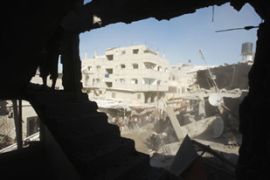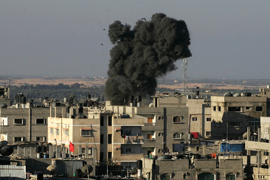Scores killed as Gaza UN school hit
Israeli shells hit UN school sheltering hundreds of civilians in Jabalya refugee camp.

John Ging, director of operations in Gaza for Unrwa, the United Nations Relief and Works Agency, said three artillery shells landed near the school where 350 people were taking shelter.
Ging said Unrwa regularly provided the Israeli army with exact geographical co-ordinates of its facilities and the school was in a built-up area.
 |
| A Palestinian boy taking refuge at a UN school in Gaza [Reuters] |
“Of course it was entirely inevitable if artillery shells landed in that area there would be a high number of casualties,” he said.
Mark Regev, spokesman for the Israeli prime minister, said: “The initial findings … are that there was hostile fire at one of our units from the UN facility.
“Our unit responded. Then there were explosions out of proportion to the ordnance we used,” he said.
Avital Liebowitz, an Israeli military spokesperson, told Al Jazeera that Hamas had “booby-trapped” installations in Gaza and Israel had no choice but to retaliate.
Earlier in the day, two people were killed when an artillery shell hit a school in the southern town of Khan Younis and three people were killed in an air strike on a school in the Shati refugee camp in Gaza City, medics said.
More than 640 people have been killed and 2,800 others wounded in the 11-day operation, most of them civilians.
Widening the operation
The Israeli military also appears to be broadening its assault on the Gaza Strip as heavy artillery fire is reported from the southern Gazan city of Khan Younis.
| IN DEPTH |
 Latest news and analysis from Gaza and Israel |
 Al Jazeera Labs: Report on and track the war |
 Send us your views and eyewitness videos |
 Watch our coverage of the war on Gaza |
Palestinian witnesses said Israeli tanks had moved into Khan Younis, the second biggest urban area in the Strip after Gaza City, in what seems to be an attempt to isolate it from Rafah.
Ayman Mohyeldin, Al Jazeera’s correspondent in Gaza, said Khan Younis is strategically significant on several levels – including that Palestinian fighters can fire missiles into Israeli territory from there.
He stressed reporting teams cannot confirm the reports as they are unable to reach the south from Gaza City in the north because the Strip has been effectively dissected by a column of Israeli troops.
Mohyeldin also said Palestinian factions had reported that the Israeli navy was attempting to land near the central coastal city of Deir al-Balah – the scene of more intense fighting – on Tuesday.
“There was very intense shelling overnight and people woke to the presence of ground forces in and around Khan Younis this morning,” he said.
Four Israeli soldiers were killed and 24 wounded in battles around Gaza City on Monday night, the Israeli military said early on Tuesday, bringing the Israeli death toll to eight.
Nowhere to hide
Fierce clashes between Israeli troops and Palestinian fighters were also reported in Jabaliya in the northern Gaza Strip and two black plumes of smoke could be seen rising over the area.
Fares Akram, a Gaza city resident, told Al Jazeera there was “no safe place in Gaza” as “the Israeli war planes don’t stop dropping bombs and firing missiles into Gaza”.
Akram says his wife, who is nine-months pregnant, is living in fear of going into labour both because of how dangerous it is to leave their home and because “she knows hospitals in Gaza are in chaos”.
He said that while Gazans appreciated demonstrations staged across the Arab world in protest at Israel’s actions in the Strip, most believe that while the US backs the Israeli offensive the assault will continue.
In addition, the humanitarian situation in Gaza – already poor following the 18-month Israeli blockade of the strip that left the territory desperately short of fuel, food and medical supplies – is worsening.
John Ging, the head of Unrwa, said he was “shocked” by “the brutality of the injuries” he had seen during a visit to the Shifa hospital in Gaza.
‘Absence of accountability’
He said: “There are very real shortages of medicine. This hospital has not had electricity for four days. If the generators go down, those in intensive care will die. This is a horrific tragedy here, and it is getting worse by the moment.
 |
| Smoke rises after an Israel air strike near the border between Egypt and Gaza [AFP] |
Ging described the situation as “the consequences of political failure and complete absence of accountability for this military action” and appealed for political leaders in the region and around the world to “take on the responsibility”.
A number of diplomatic initiatives are under way in the region, with Nicolas Sarkozy, the French president, visiting Israel and Syria on Tuesday for talks aimed at brokering a ceasefire.
Sarkozy, speaking with Bashar al-Assad, his Syrian counterpart, called on Syria to use its weight to influence Hamas.
“Syria needs to apply its weight to both sides, but in particular to Hamas that the missile attacks stop,” he said in the Syrian capital, Damascus.
“Syria has to convince Hamas to make a choice for peace, reason and logic and that they themselves become the agent of reconciling Palestinians. We have to get to the point where we can solve this problem.
“There are still a few hours left for us to carry on talking, but I am convinced if both sides are prepared to take the first step, the fighting can stop. The images we have seen are unbearable for all of us.
“It is up to each side to make the first step, with help from Europe, Turkey and Egypt… to escape the spiral of violence and replace it with a spiral of peace.”
Israel launched its offensive on the Strip after a fragile six-month ceasefire with Hamas – the Palestinian faction that controls Gaza – ended on December 19.
Both sides blame each other for the failure of the ceasefire, with Israel saying Palestinian fighters breached the truce by firing rockets into southern Israel.
Hamas, and other Palestinian groups, say the truce could not be extended because Israel failed to lift its crippling siege of the Strip.